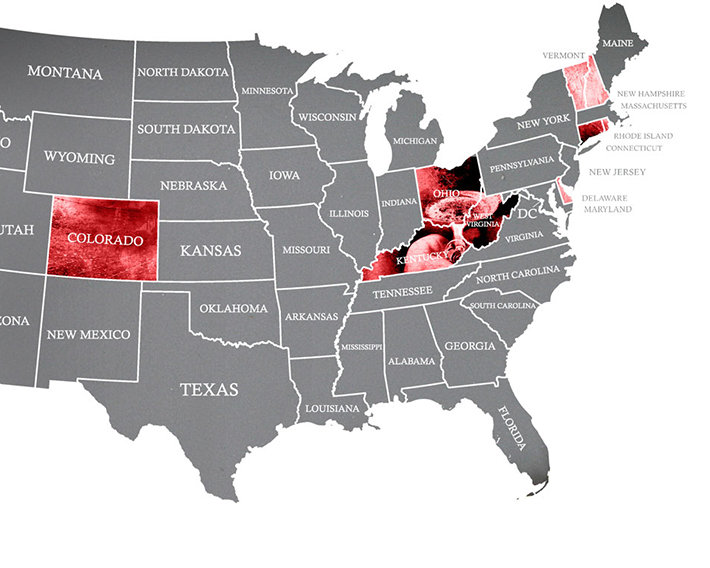2017’s Overdose Numbers Reveal Catastrophic Levels of Loss
Could you live in a state where every year, more than 5,000 people die of drug overdoses? More than 60 million Americans do.
- California: In 2017, 5,060 Californians were lost to drug overdoses, the highest number ever lost in a year.
- Ohio: Also in 2017, Ohio topped California’s number and went on to lose 5,293.
- Pennsylvania: And finally, in 2017, this state lost 5,692 of its citizens.
To understand the actual impact of these figures, it’s vital to compare them to the state’s population. Here’s recent population figures for each of these three states.
- California: 39,250,000
- Ohio: 11,613,000
- Pennsylvania: 12,802,000
Proportionally, then, families in Ohio and Pennsylvania struggled with loss far more often than families in California.

On the other hand, little West Virginia has a population of less than 2 million people, but the state buried more than a thousand people in 2017. If California lost its citizens at the same rate as West Virginia, it would rack up roughly 20,000 losses PER YEAR.
Here’s the graph provided by the Centers for Disease Control and Prevention for drug overdose deaths for the whole country. Every dot shows the estimated number of deaths for the prior 12 months ending in that month. The highest 12-month figure was reached in October 2017 with 70,566 reported deaths.

Which State Had the Highest Rate of Loss?
Using 2016 figures, for every 100,000 residents in the state:

- West Virginia lost 52.
- Ohio and New Hampshire lost 39.
- Pennsylvania lost 38.
- Kentucky lost 34.
These 2017 Figures
These figures published by the CDC are preliminary and will increase slightly when all 2017 autopsies and investigations are complete. For example, West Virginia’s known overdose deaths for the twelve-month period ending in October 2017 came to 1,105 but the final number is predicted to be 102 deaths higher when data tabulation is complete.
You might have noticed that the numbers began to dip slightly at the end of 2017 after a peak in October. Using the available data and a prediction of what the final number is likely to be, it looks like America lost 72,306 lives in the twelve months ending December 2017.
Any time you want, you can review the chart above and all the numbers for your state. You can find the chart above plus monthly figures for the country or your state here: CDC Report on Drug Overdose Deaths.
How does 2017 compare to earlier years?
- Estimated 2017 losses: 72,306 deaths
- 2016: 63,600 deaths
- 2015: 52,404
- 2014: 47,055
Between 2015 and 2016, the rate of overdose deaths increased 21%. Much of that increase can be attributed to the widespread availability of fentanyl in the American illicit drug supply. The increase in fentanyl in our drug supplies is tracked by the Drug Enforcement Administration (DEA). In 2013, the DEA reported that fewer than a thousand drug samples tested positive for fentanyl. By 2015, the number had reached 14,000.

Does the End-of-Year Dip Indicate Improvement?
It’s unlikely that the reason for this dip was fewer people using drugs. It’s more likely that the widespread distribution of the opioid antidote naloxone is responsible for the slightly lower numbers. While saving lives is vital, it only skims the surface of what actually needs to be accomplished.
There are many voices calling for all of those addicted to opioids to be started on a buprenorphine formula—usually Suboxone, composed of buprenorphine and naloxone—designed to replace the medical or illicit drugs the person was addicted to. This action can help a person get off the streets and into a law-abiding and healthier lifestyle but this too is shortsighted if the improvement we expect ends there.
The ideal result of drug treatment or rehabilitation is to return individuals to the condition they were in before they began using drugs, or as close to that condition as possible. In the rush to distribute more pharmaceuticals as a solution to addiction, this result can be overlooked. Before addiction, this person was sober, healthy and not reliant on any substances. Not alcohol, not methadone, not Suboxone or heroin or fentanyl.
This kind of recovery is possible. Families caught in the panicked confusion of trying to save a loved one’s life may accept a doctor’s recommendation of a prescription of Suboxone for the rest of the addicted person’s life. But that is not the only path out of addiction. True rehabilitation does exist. You can call us to find out how Narconon has been accomplishing this goal for more than fifty years.


 ®
®